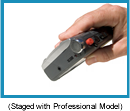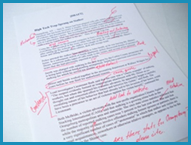Victim Media Advocacy:
How to Facilitate Sensitive and Respectful Treatment of Crime Victims
PAGE INDEX
a. Helping Victims Prepare
i. Preparation
ii. Explaining Editing To Victims
b. Tips for Media Interviews
c. During the Interview
d. Follow-Up
Guidelines for Media Interviews
These guidelines can help victims who choose to speak to the media think about and plan for their interactions with the news media.
1. PLAN INTERVIEWS: You should plan for media interviews.
The most effective media interviews are those that are carefully considered in advance, with attention paid to the key points that victims want to make. Advocates can help victims think about and outline what they want to say in order of priority to ensure that their key messages are conveyed concisely and to the point. When possible, advocates can role play with victims so that they understand the process and gain experience in fielding questions.
2. DEMAND RESPECT: You should expect to be treated with respect by the news media.
While media interviews can be stressful to victims, they should always be conducted in a manner that is courteous and respectful. Victims and advocates should discuss strategies about how to respond if they are not. It may make sense to have a prearranged signal that victims can use to alert the advocate to end the interview if certain boundaries are crossed.

3. SAYING NO: You do not have to speak to the media and can say “no” to requests for interviews, even if you have previously granted interviews.
Victims should never feel required to speak about their victimization, and advocates can explain to journalists how important it is for victims to regain control over their lives in the aftermath of crime. Victims should never feel pressured to grant an interview. Journalists should also be told that there may be specific times—such as during a trial, or when they are feeling trauma or stress—when victims can’t speak to the media. Advocates should advise victims that it is completely up to them to decide if and when they wish to speak to the media and they should not allow themselves to be pressed into an interview.
4. CHOOSE WHEN AND WHERE: You can select the date, time, and location for a media interview.
Victims can take charge of the process by granting interviews that fit within their schedules and their lives. However, advocates should explain that the media often work on tight deadlines, so it’s a good idea to try and meet their scheduling needs to the degree possible.
5. OPTING FOR A SPOKESPERSON: You can select a spokesperson or advocate of your choice to speak on your behalf to the media.
Some victims choose to have a family member, friend, or victim service provider represent them with the media, either as their principal spokesperson or in cases where it is not possible to conduct an interview. Advocates can advise victims to choose somebody they trust and to establish clear guidelines for representation (such as key points they want to make and issues that they consider “off limits” for interviews).

6. OPTING FOR A SUPPORT PERSON: You can ask to have a support person present with you during any interview.
Advocates should advise victims and journalists that the more comfortable they are in an interview setting, the better the interview will be. Sometimes it’s a good idea to have a family member, friend, or victim service provider with them to provide moral support and comfort.
7. RELEASING WRITTEN STATEMENTS: You can release a written or oral statement through a spokesperson instead of an interview.
The benefits of a written or oral statement are that the media get at least part of the information they are seeking, the victim’s feelings and opinions are clearly conveyed, and there is no margin of error for inaccuracies.
8. ONE AT A TIME: You can avoid a stressful atmosphere by speaking to only one reporter at a time.
For some victims, a press conference can be overwhelming. Victim service providers can help victims schedule individual interviews at the time and location of their choosing.

9. ESTABLISH GROUND RULES: You can establish “ground rules” or boundaries for all media interviews.
Victim service providers can help victims consider “ground rules” that can facilitate a more effective interview and avoid discussing issues that are potentially traumatic. Examples include the victim’s desire for a support person to be present; topics that are “off limits;” any limitations on visual depictions of the victim’s face or visual image; and an agreement to take breaks during the interview or end it if needed.
10. DON’T HAVE TO ANSWER: You can refrain from answering any question that makes you uncomfortable.
Advocates should clearly advise victims that they do not need to answer a question just because it is asked. If a question appears to be insensitive or makes a victim uncomfortable, the victim (or his/her support person) can simply state that he or she is unwilling to answer or ask that the question be rephrased.
11. ENDING INTERVIEW: You can end an interview at any time.
Advocates should remind victims that participating in a media interview is their choice. If an interview becomes too stressful, it is the victim’s choice to end it.
12. TAPE IT YOURSELF: You can audiotape or videotape all interviews to ensure the accuracy of what you say.
Advocates can provide victims with taping equipment to document their interviews.
13. ASK WHAT ITS ABOUT: You can ask in advance what the story will be about.
If victims have an idea about the scope of the story, they can better prepare for an interview. Most reporters will give victims or their advocates a general idea of what the story is about. However, victims need to know that editors almost always have the last say about what the story will ultimately say.
14. ASK FOR A SPECIFIC REPORTER: You can request a specific reporter.
In the course of a criminal investigation and trial, victims may identify a reporter with whom they are comfortable and, to the contrary, reporters with whom they are uncomfortable. They may also ask the advocate’s advice about which reporter to talk to. Choosing a specific reporter is another element that can help victims regain control following a crime.
15. REFUSING SPECIFIC REPORTERS: You can refuse an interview with a specific reporter, even if you have granted interviews to other reporters.
Victims should refuse an interview with a reporter who has been insensitive or has covered their case inaccurately.

16. EXCLUDE CHILDREN: You can and should exclude young children from interviews.
Young children are particularly vulnerable to the traumatic effects of a crime. They rely on adults for support and decision-making, and to protect them from further harm. Advocates can advise the parents and guardians of children to avoid exposing them to the public eye, especially in times of crisis. Parents and guardians can speak on behalf of their children while still protecting their identity. (See “Child Victims.”)
17. DEMAND CORRECTIONS: You can demand a correction when inaccurate information is reported.
If victims feel that information is not accurate or that they were misquoted or taken out of context, it’s important to raise these concerns with reporters and their editors. Mistakes are usually unintentional and can be corrected.
 18. REFUSING PHOTOS: You can conduct a television interview using a silhouette or a newspaper interview without having your photograph taken.
18. REFUSING PHOTOS: You can conduct a television interview using a silhouette or a newspaper interview without having your photograph taken.
Advocates can advise victims that their right to privacy should not preclude them from granting interviews, since modern technology can protect their privacy without preventing them from speaking to the media.
19. TELLING YOUR SIDE: You can completely give your side of the story related to your victimization.
Advocates can advise victims about the many sources that are available to reporters who are covering their cases and let them know that their insights and perspective are important.
20. FILING A COMPLAINT: You can file a formal complaint against a journalist.
You may first want to talk with the reporter about your complaint. If you do not get satisfaction, you can send a formal complaint to their editors or news directors, as well as publishers and owners.
a. HELPING VICTIMS PREPARE: Helping Victims Prepare for Media Interviews
The Role of the Victim Service Provider19 19. Ibid., 15.
The most important part of preparation is establishing the victim’s goals for the interview. What does the victim want to say? Are there specific messages he or she wants to convey? Is there information already in the public that he or she wants to correct or comment on? Remember that it is difficult to convey more than a few distinct messages, so advocates can help victims hone their presentations.
Additional preparation involves sharing knowledge, answering questions, rehearsing, and preparing for logistics:
- Educate victims about the media. Begin by asking victims what they know and would like to know about the media. By establishing a baseline, advocates can provide the most important information and avoid being condescending to victims who already have experience with media relations.
- Explain how the media operate. While a victim will deal directly with a reporter, there are also editors, managing editors, photographers, and headline writers who contribute to print stories, and editors, news directors, and camerapersons who contribute to broadcast stories (see Section 2, “Types of News Media”).
- Explain what you know about the person conducting the interview. Give the victim the journalist’s name, media affiliation, type of publication or radio/television station, its audience, and any details known about the style of interviewing. Offer any insights about the interviewer based on your past personal experiences. You can use Internet search engines to find past stories done by the journalists, both print and broadcast, to share with the victim.
- Ask if the victim wants someone there with them. Discuss whether a support person (family member or friend) or victim service provider should accompany the victim to the interview and what role the support person should play. Make sure to negotiate this with the reporter on the victim’s behalf and facilitate this process with both the victim and the reporter.
- Confirm the logistics of the interview in advance. You will want to know the date, time, location (including directions), length of the interview, and name of the reporter. Plan to arrive at least 30 minutes in advance of the interview. For a telephone interview, in addition to being ready in advance, make sure you have the reporter’s telephone number in case of technical difficulties.
- Determine the format of the interview. Is it live or taped? In-person or over the telephone? What is the anticipated length of the interview? For broadcast media, are there other guests or will the victim be the only interviewee?
- Determine the topic. Find out what the reporter wants to talk about and provide the victim with a framework for the interview (while advising that other topics may be introduced).
- Attempt to identify others who have been contacted. If possible, determine in advance who else the journalist has spoken to. It’s important for victims to know in advance, for example, that the alleged or convicted defendant or his/her counsel has been interviewed for a story.
- Explain preinterviews and working with producers. Broadcast media often require a preinterview or an informal discussion with a producer before the on-camera or on-air interview. Advocates should explain this process. It’s an opportunity to discuss and confirm basic facts and details, obtain correct spelling of names, establish ground rules, and answer any questions the victim may have. When conducted close to the time of the interview, it can also be an opportunity to warm up and get comfortable prior to the actual interview. Note, however, that questions may be asked during the interview that were not asked during the preinterview.
- Provide information and context to the reporter. Consider additional information that may be helpful to reporters (such as crime statistics or local crime trends, information about victims’ rights or services, etc.) and offer it to them.
 Negotiate ground rules, if any. Ask if the victim would like to establish any “ground rules” for interviews. This could include whether the victim can ask questions of the journalist to clarify any issues or concerns. You might want to specify the length of the interview, the presence and role of a support person, topics that are “off limits,” and the victim’s ability to end the interview at any time. Explain that journalists may also have ground rules that they want honored. Reporters have conventions such as “off the record” and “only on background” that dictate what they can and cannot use in their stories. However, this is an area where confusion and errors can mean that unintended comments are included. Crime victims should operate under the assumption that anything they say can be included.
Negotiate ground rules, if any. Ask if the victim would like to establish any “ground rules” for interviews. This could include whether the victim can ask questions of the journalist to clarify any issues or concerns. You might want to specify the length of the interview, the presence and role of a support person, topics that are “off limits,” and the victim’s ability to end the interview at any time. Explain that journalists may also have ground rules that they want honored. Reporters have conventions such as “off the record” and “only on background” that dictate what they can and cannot use in their stories. However, this is an area where confusion and errors can mean that unintended comments are included. Crime victims should operate under the assumption that anything they say can be included.
- Determine if victims have any privacy concerns. Is the victim willing to be interviewed without being identified by name or being photographed or filmed? How will the person speaking on behalf of a child victim be identified so that the child is not directly or indirectly identified? Convey these concerns to the interviewer.

- Discuss taping the interview on the victim’s behalf. Advise the victim that he or she can audiotape or videotape any interviews to provide his or her own documentation and avoid any inaccuracies in what is said.
- Brainstorm possible issues and questions to be covered. Anticipate questions that may be asked and review these with the victim.
- Rehearse in advance of the interview. Use the questions identified above to discuss possible answers. Advocates can role play the role of the reporter so that the victim can gain mastery of the process. Practice and constructive feedback can help victims feel more confident and concise in their responses.
- Carefully review “Tips for Media Interviews” with victims to help them prepare.
If the victim is a survivor of a homicide victim, there are additional issues to address:
- Portrayal of the loved one. How do the survivors want their loved one remembered? It’s important to depict exactly who the homicide victim was in order to convey the devastating sense of loss to the survivors. Professional accomplishments, the victim’s favorite hobbies and leisure activities, civic and charitable contributions, and personal anecdotes and information about immediate survivors are all issues that reporters may want to cover.
- Providing visuals. Do the survivors have favorite photographic options (for print media) (e.g., a simple photograph of the homicide victim alone, along with visuals that show the person with other family members, engaged in favorite activities, at work, etc.?)

- Access to others. The media may want to speak to other family members, professional colleagues, and friends who knew and loved the homicide victim. Advocates can work with the victim to identify and provide contact information for such persons to the media.
- Issues with young people. For younger homicide victims, information about the child’s personality and favorite activities, subjects in school, and hobbies are all important to convey. Advocates can help survivors identify a favorite teacher or coach who can also talk about the child.

- In addition, victim service providers should determine the victim’s wishes about media coverage at the funeral, wake, or memorial events and convey these wishes to the media.
 It’s important for victims to understand that the reporter to whom they speak is only one person among several who are responsible for editing an article or news broadcast. It is an ongoing process that begins when a story is assigned and ends only when it is published or broadcast. Editing can be done by a reporter, editor, copy editor, or news director.
It’s important for victims to understand that the reporter to whom they speak is only one person among several who are responsible for editing an article or news broadcast. It is an ongoing process that begins when a story is assigned and ends only when it is published or broadcast. Editing can be done by a reporter, editor, copy editor, or news director.
Editing helps make sure that a story is accurate, clear, understandable, and objective, and that space and time constraints do not affect the quality or factual information in a story. Editing focuses on accuracy, style, spelling and grammar, and length of the article or broadcast, as well as lack of bias.
When victims understand the editing process, they can also understand how important it is to—
- Be concise. Longer statements are more likely to be edited than those that are brief and to the point.
- Be accurate.

- Focus on facts. It is important to separate facts from personal opinions or perspectives. When citing facts, cite solid sources. When citing opinions, be clear that it is a personal perspective.
- Speak plainly. Avoid terminology or jargon that is confusing to media audiences.
Victim service providers can offer basic tips to victims to help them prepare for media interviews. The following suggestions can be augmented with tips based on their past personal experiences and knowledge of the specific news medium or reporter involved:
- Relax and be yourself. Your level of personal comfort will improve your interview experience.
- Be sincere and honest. Your personal credibility is your most important asset!
- Know what you want to say. Be prepared with two or three key points you want to make and find a way to make them early in the interview. For example: “The one thing I really want to say is. . .,” or “My most important message is. . .” Return to those messages and repeat them in different forms whenever you can.
- Speak slowly and clearly. Think about the question, then think about your answer.
- Keep your answers brief and succinct. You can follow a brief answer with more details, but make sure the most important information is conveyed first, simply and to the point. Consider preparing pithy quotes in advance.
- Once you make your point, stop talking. Don’t worry about silence. It is not your job to fill it. Talking beyond your stopping point makes it harder to edit your quotes. It is also when many people say things they wish they hadn’t.
- Send your messages. You can reinforce your key points by repeating them.
- Listen to the entire question before answering it. Take the time needed to formulate your response. In broadcast interviews, overlapping your answer with the interviewer’s question can make it difficult for editors.
- Make sure you know what is being asked. If you don’t understand a question, ask for clarification.
- Refuse politely. If an interviewer’s question makes you feel uncomfortable, simply say, “I’m not comfortable answering that question.”
- Don’t overextend. If you don’t know the answer to a question, simply say so. If you feel you can’t respond, give a brief reason, such as, “I’ll be able to answer that once the jury reaches its verdict.”
 Never say, “No comment.” You can say, “I’m unable to answer that question at this time” or “I don’t have enough information to fully address your question.”
Never say, “No comment.” You can say, “I’m unable to answer that question at this time” or “I don’t have enough information to fully address your question.”
- Avoid going “off the record.” Simply assume that everything you say is “on the record” and speak accordingly.
- Don’t interrupt the interviewer or other guests. Likewise, if you feel you are being interrupted, you can say, “If it’s okay, I’d like to finish what I was saying.”
- Speak plainly. Avoid any jargon or acronyms that may be confusing to readers, listeners, or viewers.
- Avoid distractions. Do not use hand gestures that may block your face or expressions that detract from the content of the interview. Don’t wear jangly or shiny jewelry to broadcast interviews or anything else that might make noise that microphones might pick up. Avoid tapping your fingers or your feet.
- Correct errors or misperceptions. If inaccurate information is presented in the course of an interview, present the facts to correct it in a positive manner.
- Avoid fatigue. If you need to take a break (except during live interviews), ask for one.
- Don’t feel guilty about being human. Always remember that what happened to you was bad and is possibly distressing to you. It’s okay to show emotions during an interview.
- Emphasize your story. Remember that you are speaking for yourself. It’s important to avoid making generalizations that appear to represent all victims.
 Click here for printable pdf of list above.
Click here for printable pdf of list above.
A one-page summary of the above, “Quick Tips for Crime Victims and Survivors: Conducting Media Interviews,” is included in the Resources section of this guide.
c. During the Interview: Supporting Victims During the Interview
The victim’s comfort level—both physical and emotional—will directly affect the actual interview. A victim who is well prepared will feel a greater sense of confidence and control.
By acknowledging that interviews may be stressful, victim service providers can help victims prepare. Explain stress-reduction techniques—such as deep breathing, physical stretching, or visual imagery—that victims can use to relax immediately prior to interviews.
The advocate can help plan for a comfortable physical environment. If the interview is conducted at the home or office of the victim, the victim can choose the place where he or she feels most comfortable talking. The advocate can arrange the physical space to avoid clutter, have a box of tissues on hand, ensure there is appropriate light and space, and provide for electrical outlets or extension cords for the media. The goal is to facilitate an interview setting that is quiet (no external noise, cell phones and pagers turned off, etc.). A glass of water should be provided for both the victim and the interviewer.
If the interview is conducted in a studio or other environment, the advocate can work with media professionals to address physical comfort needs (see above). Advocates should address, review, and discuss key interview logistics with victims such as—
- The person who is conducting the interview and how he/she would like to be addressed.
- Different personnel responsible for production, light, sound, and makeup.

- Provision of lavaliere microphones and conducting sound checks (advocates should explain to journalists that victims may not want to be touched in the process of receiving a microphone).
- Guidelines for speaking directly to the interviewer or camera(s).
- If and how visuals will be used.
- If and how other guests will be involved.
If the interview is conducted from a remote location, the advocate can—
- Determine and advise the victim about the length of the interview.
- Arrange for the victim and interviewer to speak in advance, in person or by telephone, to enhance their familiarity and comfort with each other.
- Explain equipment and logistics related to remote interviews—such as cameras, microphones, earpieces, and sound checks—and ensure that the victim is comfortable with the equipment and process.
- Work with producers to determine where the victim should look during the interview and how to identify where to look when multiple cameras are used.

d. FOLLOW UP: Following Up After the Interview
Following an interview, victims may seek feedback from advocates about their interview style and the information they conveyed. Advocates should first discuss how the victim felt about the interview. It is important to be frank about any times when the victim felt particularly positive or perhaps stressed. Constructive feedback can help victims improve their interview techniques and gain confidence for the future.
Victim service providers should determine, to the degree possible, when a story will be published or aired and inform the victim. If a victim wants to document interactions with the media, the advocate can help him or her prepare a scrapbook or obtain audiotapes and videotapes of interviews.
All media contacts can be added to a centralized media database for future reference.
 Any interactions with the media provide victims and advocates with an important opportunity to build strong, ongoing relationships. If a story is fair and accurate, a brief thank you note or e-mail to the reporter—or his/her editor or news director—recognizes the reporter’s good work. If victims or advocates are pleased with the results of a print interview, they can also write a letter-to-the-editor for publication that expresses their feelings.
Any interactions with the media provide victims and advocates with an important opportunity to build strong, ongoing relationships. If a story is fair and accurate, a brief thank you note or e-mail to the reporter—or his/her editor or news director—recognizes the reporter’s good work. If victims or advocates are pleased with the results of a print interview, they can also write a letter-to-the-editor for publication that expresses their feelings.
If a victim feels that an article or news broadcast contains information that is inaccurate or taken out of context, the advocate can help develop a plan-of-action to express such concerns:
- Create specific documentation of erroneous information.
- Advise the victim to document any concerns in writing.
- Speak first directly to the reporter and, if needed, to editors or news directors about the victim’s concerns.
- Seek a correction either in print or on air.
Quick Tips for Crime Victims and Survivors
Guidelines for Media Interviews
- You should plan for media interviews.
- You should expect to be treated with respect by the news media.
- You do not have to speak to the media and can say “no” to requests for interviews, even if you have previously granted interviews.
- You can select the date, time, and location for a media interview.
- You can select a spokesperson or advocate of your choice to speak on your behalf to the media.
- You can ask to have a support person present with you during any interview.
- You can release a written or oral statement through a spokesperson instead of an interview.
- You can avoid a stressful atmosphere by speaking to only one reporter at a time.
- You can establish “ground rules” or boundaries for all media interviews.
- You can refrain from answering any question that makes you uncomfortable.
- You can end an interview at any time.
- You can audiotape or videotape all interviews to ensure the accuracy of what you say.
- You can ask in advance what the story will be about.
- You can request a specific reporter.
- You can refuse an interview with a specific reporter, even if you have granted interviews to other reporters.
- You can and should exclude young children from interviews.
- You can demand a correction when inaccurate information is reported.
- You can conduct a television interview using a silhouette or a newspaper interview without having your photograph taken.
- You can completely give your side of the story related to your victimization.
- You can file a formal complaint against a journalist.
 Click here for printable pdf of list above.
Click here for printable pdf of list above.
Quick Tips for Victims and Survivors:
Conducting Media Interviews
- Relax and be yourself. Your level of personal comfort will improve your interview experience.
- Be sincere and honest. Your personal credibility is your most important asset!
- Know what you want to say. Be prepared with two or three key points you want to make and find a way to make them early in the interview. For example: “The one thing I really want to say is. . .,” or “My most important message is. . .” Return to those messages and repeat them in different forms whenever you can.
- Speak slowly and clearly. Think about the question, then think about your answer.
- Keep your answers brief and succinct. You can follow a brief answer with more details, but make sure the most important information is conveyed simply and to the point. Consider preparing pithy quotes in advance.
- Once you make your point, stop talking. Don’t worry about silence. It is not your job to fill it. Talking beyond your stopping point makes it harder to edit your quotes. It is also when many people say things they wish they hadn’t.
- Send your messages. You can reinforce your key points by repeating them.
- Listen to the entire question before answering it. Take the time needed to formulate your response. In broadcast interviews, overlapping your answer with the interviewer’s question can make it difficult for editors.
- Make sure you know what is being asked. If you don’t understand a question, ask for clarification.
- Refuse politely. If an interviewer’s question makes you feel uncomfortable, simply say, “I’m not comfortable answering that question.”
- Don’t overextend. If you don’t know the answer to a question, simply say so. If you feel you can’t respond, give a brief reason, such as, “I’ll be able to answer that once the jury reaches its verdict.”
- Never say, “No comment.” You can say, “I’m unable to answer that question at this time” or “I don’t have enough information to fully address your question.”
- Avoid going “off the record.” Simply assume that everything you say is “on the record” and speak accordingly.
- Don’t interrupt the interviewer or other guests. Likewise, if you feel you are being interrupted, you can say, “If it’s okay, I’d like to finish what I was saying.”
- Speak plainly. Avoid any jargon or acronyms that may be confusing to readers, listeners, or viewers.
- Avoid distractions. Do not use hand gestures that may block your face or expressions that detract from the content of the interview. Don’t wear jangly or shiny jewelry to broadcast interviews. Avoid tapping your fingers or your feet.
- Correct errors or misperceptions. If inaccurate information is presented in the course of an interview, present the facts to correct it in a positive manner.
- Avoid fatigue. If you need to take a break (except during live interviews), ask for one.
- Don’t feel guilty about being human. Always remember that what happened to you was very bad and is possibly distressing to you. It’s okay to show emotions during an interview!
- Emphasize your story. Remember that you are speaking for yourself. It’s important to avoid making generalizations that appear to represent all victims.
 Click here for printable pdf of list above.
Click here for printable pdf of list above.




